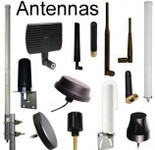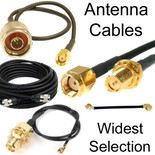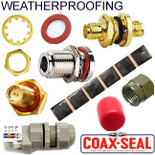Antennas, Antenna Cables, Wireless Products: Technical Articles
Antenna Cable Tests: S11, SWR & S21 for RF Coax Assemblies
Table of Contents
- S11, SWR, and S21: Test Types of Coaxial Cables and Connectors.
- Coaxial Cable Assembly Test Reference
- Quick Rules of Thumb
- Understanding S11 LogM, S11 SWR, and S21 LogM in Coaxial Cable Testing
- S11 LogM – Return Loss as a Measure of Match Quality
- S11 SWR – A Technician-Friendly Reflection Metric
- S21 LogM – Insertion Loss as the True System Cost
- Conclusion
- FAQs
S11, SWR, and S21: Test Types of Coaxial Cables and Connectors.
S11, SWR and S21 are the most common tests for RF coaxial cable assemblies, connectors, and antenna cables with a Vector Network Analyzer (VNA) or similar RF test equipment.
S11 LogM reveals how much of your signal is bouncing back.
S11 SWR translates that same mismatch into a field-friendly ratio.
S21 LogM tells you how much of your signal actually makes it through.
Coaxial Cable Assembly Test Reference
| Test Name | What It Measures | Typical Units / Display | How to Interpret Results | Application for RF / Antennas |
|---|---|---|---|---|
| S11 LogM (Return Loss) | Reflection at port 1 (how much signal is reflected back due to impedance mismatch). | dB (logarithmic magnitude of S11). | - More negative dB = better. - Example: –20 dB → only 1% reflected (good). - –10 dB → ~10% reflected (acceptable for some systems). | Ensures the coax + antenna + connectors are well-matched to 50 Ω. Poor values mean loss of power and potential interference. |
| S11 SWR (Standing Wave Ratio) | Ratio of forward vs. reflected power, derived from S11. | Ratio (e.g., 1.2:1, 2:1). | - 1.0:1 = perfect match. - < 1.5:1 = very good. - < 2.0:1 = usually acceptable. - Higher ratios indicate mismatch and higher reflection. | Easy-to-read metric for installers. Used in antenna tuning and quick cable checks. |
| S21 LogM (Insertion Loss / Forward Transmission) | Transmission from port 1 → port 2 (how much signal makes it through the cable/assembly). | dB (logarithmic magnitude of S21). | - Closer to 0 dB = better. - Example: –0.5 dB = ~11% loss (good for short cables). - –3 dB = 50% power loss (significant). | Quantifies cable loss over frequency. Critical for long runs, high frequencies, and low-power systems. |
Quick Rules of Thumb
- S11 (Return Loss / SWR): Tells you how well the cable + load is impedance-matched.
S21 (Insertion Loss): Tells you how much signal is lost along the way.
For high-performance RF/wireless:
S11 LogM ≤ –15 dB (≈ SWR ≤ 1.5:1) is desirable.
S21 LogM should be as close to 0 dB as possible; expect higher losses at higher frequencies and longer cables.

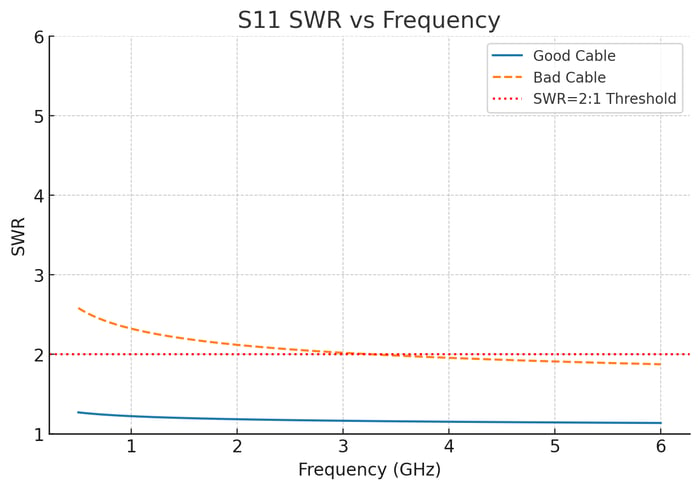
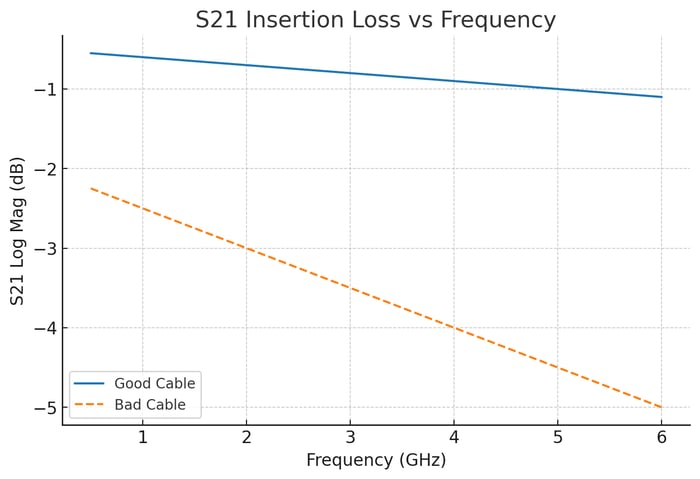
Understanding S11 LogM, S11 SWR, and S21 LogM in Coaxial Cable Testing
When evaluating coaxial cable assemblies, connectors, and antenna cables, three measurements dominate in practical use: S11 LogM, S11 SWR, and S21 LogM. These parameters, measured with a Vector Network Analyzer (VNA) or similar RF test equipment, give engineers and technicians a clear picture of how well a cable assembly performs in real-world wireless systems. While the table provides a snapshot of definitions and benchmarks, it is equally important to understand why these tests matter and how to think about them in context.
S11 LogM – Return Loss as a Measure of Match Quality
S11 LogM quantifies how much energy is reflected back into the source rather than being delivered into the load. In practical terms, this tells you how well the cable and its terminations are matched to the system’s characteristic impedance (usually 50 Ω). A poor return loss is not just a number—it translates to wasted power, unpredictable signal behavior, and sometimes even interference that degrades the performance of the larger RF system.
For technicians, the key takeaway is simple: a more negative value is better. Every decibel of return loss improvement means more of the signal is being delivered to where it is intended.
S11 SWR – A Technician-Friendly Reflection Metric
While return loss is precise, many field technicians prefer SWR (Standing Wave Ratio) because it offers a more intuitive scale. An SWR of 1.0:1 is perfect, while values creeping toward 2.0:1 or higher quickly flag potential problems.
What’s important to recognize is that SWR and return loss are two sides of the same coin: one expresses mismatch as a ratio, the other in decibels. SWR is easier to communicate in the field, especially when making quick decisions about whether an antenna or cable run is acceptable. However, return loss (S11 LogM) provides the finer detail that designers and lab engineers rely on.
S21 LogM – Insertion Loss as the True System Cost
If S11 is about reflections, S21 is about throughput. S21 LogM measures how much signal power is transmitted through the cable assembly. Even a perfectly matched system will underperform if the cable attenuates too much energy.
This test is especially critical at higher frequencies or over long runs, where even fractions of a decibel translate into significant system losses. Unlike S11 metrics, which can sometimes be acceptable at “good enough” levels, S21 is uncompromising—any unnecessary loss is directly subtracted from system performance. For short jumpers, S21 is often negligible; for long or high-frequency runs, it can be the deciding factor between a working and a failing link.
Conclusion
Together, these three tests (S11 LogM, S11 SWR and S21 LogM) form the essential toolkit for assessing RF interconnects. A balanced view of all three ensures that systems don’t just work in the lab, but also remain reliable in the demanding environments where they are deployed.
FAQs
What does S11 LogM (Return Loss) measure?
S11 LogM measures how much of the signal is reflected back due to impedance mismatch at port 1.
How should I interpret S11 LogM values?
The more negative the value (in dB), the better the match. For example:
- –20 dB = only 1% reflected (excellent).
- –10 dB = ~10% reflected (acceptable in some systems).
What is S11 SWR and why is it useful?
S11 SWR (Standing Wave Ratio) expresses mismatch as a ratio of forward vs. reflected power. It’s easier to read in the field, commonly used by installers for antenna tuning and quick checks.
What are good SWR values?
- 1.0:1 = perfect match.
- < 1.5:1 = very good.
- < 2.0:1 = generally acceptable.
Higher ratios indicate mismatch and higher signal reflection.
What does S21 LogM (Insertion Loss) measure?
S21 LogM measures how much of the signal passes through the cable assembly, from port 1 to port 2.
How should I interpret S21 LogM values?
- Closer to 0 dB = better.
- –0.5 dB ≈ 11% signal loss (good for short cables).
- –3 dB = 50% power loss (significant).
What’s the difference between S11 and S21?
- S11 (Return Loss/SWR): tells you how well the cable + load is impedance-matched.
- S21 (Insertion Loss): tells you how much signal power is lost along the way.
What are recommended values for high-performance RF systems?
- S11 LogM ≤ –15 dB (≈ SWR ≤ 1.5:1).
- S21 LogM as close to 0 dB as possible, though longer cables and higher frequencies naturally add more loss.

